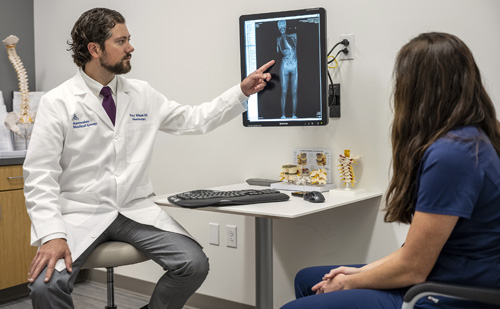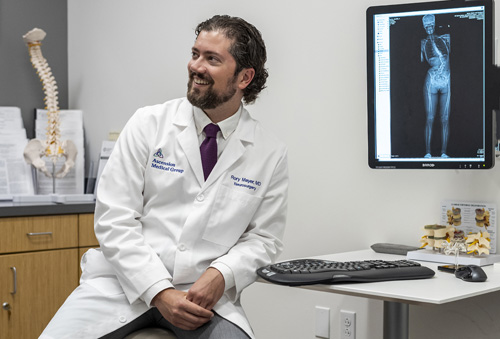Back Pain
Overview

Back strain is a fairly broad category called “soft tissue injury,” which covers muscles, tendons and ligaments. About 80% of back and neck pain is muscle-related.
The stomach muscles, or abdominals, enable the back to bend forward. They also assist in lifting. The abdominals work with the buttock muscles to support the spine. The oblique muscles go around the side of the body to provide additional support to the spine.
Another type of strain relates to spinal ligaments that run in front and in back of the vertebral bodies. Tendons, which also connect muscles in the spine, can develop inflammation, or tendonitis.
Some people believe that part of what makes the back muscles more prone to strain is that they are shorter than other big muscles in the body. The muscles in our thighs that enable us to walk, run and jump are longer and less prone to strain. It’s very unusual to strain a thigh muscle.
Causes
Muscles in the back can strain or spasm and form a hard lump, like a charley horse in the leg. Back muscle spasms can be caused by injury and pain, whether the source is muscle strain, or a disc problem. A spasm, defined as an involuntary convulsive contraction of muscle fibers, can be excruciating. The muscle spasm can be steady or come in waves of contractions. Your muscle is sending you a signal that it has been pushed beyond its ability.
Symptoms
A symptom of back strain may be an excruciating spasm in the back that is very painful.
Treatment
Surgery is never appropriate for muscle strain. As with any muscle injury, it’s natural for an individual to stop moving the injured area and wait for it to heal. Ironically, this is counter-productive. Restricting movement causes the muscle to weaken , become less flexible, and receive less circulation. In fact, gentle stretching and exercise is the best way to resolve the injury by getting it moving and increasing circulation.
 Recommendations
Recommendations
- Rest your back. Keep in mind that research has shown that more than 2 days of bed rest can be counter productive as it causes the back muscles to atrophy. After initial spasms subside, it can be helpful to take a short walk to get blood circulating.
- Apply ice for five minutes at a time for the first 48 hours, then switch to heat.
- Take anti-inflammatories, preferably ibuprofen like Advil or Nuprin as directed on the bottle. Acetominophen (Tylenol) may be taken for pain, if you are allergic to ibuprofen.
- Try our home remedy exercises. But remember, no exercise should be painful. Stop if they cause an increase in pain or symptoms.
- An appointment with a nonsurgical spine specialist is most appropriate for muscle-related back pain.
- Call us immediately if you experience any emergency, red-flag symptoms tat are listed on our Symptom Chart.
What’s the difference between a simple strain or a more serious herniated disc?
Most people erroneously think that the more excruciating the pain, the more likely that you herniated a disc. That is not the case at all. In some cases a back spasm can knock you down to your knees. A person can have excruciating pain, but if it is mostly in the low back, it’s probably not a herniated disc.
Typically, a herniated disc in your back will radiate pain down into your leg. A herniated disc in your neck will radiate pain down your arm.
When to see a doctor for back pain or neck pain?
If there is weakness or numbness in a foot or hand, these are emergency red flag signals to see a spine surgeon within 3 days, or the symptoms could become permanent and lifelong. These symptoms imply that a herniated disc is impinging upon a nerve root, like parking a car on a hose lying in the driveway and leaving it there. The hose can be crimped permanently.
